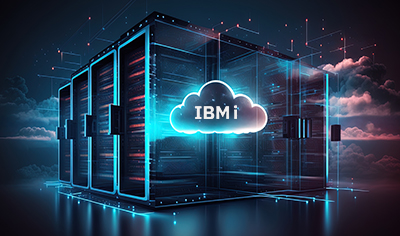The need for legacy application modernization is becoming increasingly critical for businesses in this ever-evolving technological landscape. Several technical leaders and managers are seeking help to modernize integral business applications hosted on legacy platforms like AS400 to drive operational efficiency and innovation.

For organizations utilizing AS400 systems as the enterprise application hosting platform, the urgency of embracing application modernization can’t be overstated. The choice is clear: modernize to stay relevant and competitive or face the risk of being left behind by competitors. Furthermore, the implications of missing out on AS400 application modernization are profound and far-reaching, impacting every crucial aspect of the application, from data security and integrity to scalability and performance. Now, let’s delve deeper into the challenges encountered by businesses due to the continual operation of AS400 systems and how modernization resolves them.
The Challenges of Legacy AS400 Systems and How Modernization Addresses Them Effectively
1. Increased Data Security Vulnerabilities
One of the common challenges associated with aging AS400 systems is the growing data security risk. Legacy systems like AS400 often lack encryption, access controls, and other essential security measures, making the hosted applications prone to data breaches and cyberattacks. These incidents may lead to substantial financial losses, legal liabilities, and erosion of customer trust. Furthermore, as compliance requirements evolve with time, AS400-hosted applications may struggle to meet the new data compliance standards, which in turn, further jeopardizes the business operations. For instance, regulations like HIPAA and GDPR demand stringent data protection and non-compliance can result in reputational damage. By missing out on AS400 application modernization, enterprises are leaving the door open for security vulnerabilities, data breaches, and compliance violations, which can have serious repercussions.
However, modernizing AS400 applications through cloud or containerized infrastructure facilitates easier integration of cryptographic protocols with enterprise applications. Cloud platforms offer cryptographic protocols like transport layer security (TLS), OAuth, and secure sockets layer (SSL) as a part of their intuitive security suite. Integrating these protocols with AS400 applications ensures that data remains encrypted during transit and at rest, thereby improving data security. Besides, these protocols enforce robust authentication and access control measures, enabling AS400 applications to remain highly compliant with security standards.
2. Limited Scalability
Another critical consequence of missing out on modernizing AS400 applications is limited scalability. The monolithic infrastructure of AS400 systems often lacks the agility and flexibility required to meet increasing demands and changing market dynamics. As operational requirements expand, the existing AS400 applications may not support increased workloads, which can result in reduced performance and responsiveness. This, in turn, hinders the ability to serve app users efficiently and meet their changing expectations.
AS400 modernization using microservices frameworks offers an effective way for businesses to replace monolithic architecture and boost application scalability. In simpler terms, microservices-based modernization involves decoupling the codebase and modules of an AS400 application from the underlying infrastructure. This decoupling approach reduces the interdependencies and makes it possible to scale the AS400 application instances flexibly based on varying operational demands. This level of scalability enables AS400 applications to maintain a high level of service performance under any scenario.
The Ultimate Guide to Migrating AS400/IBM i Applications
3. Increased Maintenance Costs
When organizations miss out on modernizing AS400 applications, they are not only leaving mission-critical workloads and applications vulnerable to security threats but also inadvertently setting themselves up for escalating maintenance expenses. It is important to note that AS400 is an older technology and the talent pool of iSeries professionals who can effectively maintain and troubleshoot these legacy systems is shrinking. The scarcity of skilled IBM iSeries professionals can lead to longer resolution times for issues, causing disruptions in business operations. As a result, companies are likely to pay a huge premium for the expertise required to manage and support aging AS400 applications.
Alternatively, organizations should collaborate with a reliable IBM application modernization services provider for steadfast maintenance of AS400 applications. Dedicated modernization experts effectively re-platform AS400 application to cloud and reduce dependence on manual maintenance activities like routine application updates and security patch installations. In other words, through cloud re-platforming, modernization experts automate the maintenance of AS400 applications and help businesses save time and costs.
4. Downtime and Disruptions
Maintaining the stability and security of outdated systems is an ongoing challenge. As legacy systems age, they no longer receive updates and security patches from the manufacturer and become more prone to unexpected downtime and disruptions. When mission-critical AS400 applications are not modernized, it may result in lost revenue, customer dissatisfaction, operational inefficiencies, data loss, contractual disputes, and more.
To overcome the above-mentioned consequences, adopting cloud-based modernization of AS400 applications is essential. Cloud-based modernization ensures that the AS400 applications run on distributed servers or runtime environments. This reduces the risk of downtime due to unforeseen disruptions. Moreover, the intuitive backup mechanisms in cloud platforms ensure that application data is frequently recorded ion data centers, allowing businesses to easily restore data in the event of loss.
The Ultimate Solution for Reviving Legacy AS400/IBM i Applications
5. Suboptimal User Experience
AS400-powered enterprise applications often lack modern user interfaces and workflows, making them less intuitive and efficient. This leads to slower task execution and higher error rates as users struggle to navigate through these outdated user interfaces. As a result, the workforce’s productivity hampers, which in turn, impacts the overall efficiency and competitiveness of the organization. In other words, missing out on AS400 application modernization impacts the overall user experience and performance of integral business applications.
By embracing graphical user interface (GUI) modernization approach, green-screen interfaces of AS400 applications can be reengineered without impacting business logic. The interfaces of AS400 applications are equipped with responsive layouts that easily adapt to different screen resolutions. This flexibility facilitates remote accessibility of AS400 enterprise applications, enabling workforce and teams to organize business processes with ease. Moreover, GUI modernization supports easy integration of modern technologies and platforms with AS400 applications. For instance, by integrating analytics platform with AS400 applications, users can easily gain real-time insights and make strategic decisions related to process optimization, thereby driving business productivity.
AS400 Modernization: How to Build a Successful Transformation Strategy
Modernizing AS400 applications is a time-consuming and resource-intensive initiative. Here’s a step-by-step approach to streamline the process:
I. Audit Existing AS400 Applications
To begin with, conduct an in-depth assessment of your existing AS400 applications. This will help you understand why they need to be revamped, and which modernization approach you should go for.
Here are a few factors that may be used during the evaluation process:
| Business Alignment | Does the legacy AS400 application align with existing and upcoming business goals? |
| Value | Does the application bring adequate value to the business? |
| Agility | Can the application be scaled seamlessly to accommodate the growing requirements of the organization? |
| Maintenance | Is it challenging to maintain the application and implement updates and patches? |
| Security | Does the application in any way make the business vulnerable to security risks and breaches? |
| Cost | Is the budget for maintaining and running the application exorbitant? |
II. Select the Right Modernization Approach
For anyone revamping their legacy AS400 applications, many options are available. Businesses may choose one or the other depending on their specific requirements, budget, timeline, and risk appetite.
The commonly chosen approaches include:
| Encapsulate | The application’s data and features are encapsulated and made available as services using an API. |
| Rehost | The application is redeployed to a new physical, virtual, or cloud environment without any modifications in the underlying code or features. |
| Replatform | The application is moved to a new runtime platform, with minimal changes to the code but none to the features or functions. |
| Refactor | The code is optimized to eliminate technical debt and obsolete features. |
| Rearchitect | The code is significantly altered and moved to a new application architecture in order to improve its capabilities. |
| Rebuild | The application is built from the ground up while keeping intact its scope and specifications. |
| Replace | The existing application is discarded and replaced with a new one. |
III. Engage Key Stakeholders
Modernization impacts the security and stability of those who are accustomed to working with legacy systems for decades. To minimize resistance and get buy-in for executing the project, it is essential to consult with such stakeholders before and during the transition. They may provide insights into which features should be included in the application or which mistakes to avoid during implementation. From the end-users who interact with the AS400 application regularly to the developers responsible for maintaining it, ask for everyone’s opinion and see if it can be incorporated into the modernization plan.
IV. Select the Right Technologies
A crucial factor that dictates the success of a modernization initiative is the selection of suitable tools, frameworks, and programming languages. It is essential to choose technologies that align with the long-term goals of your business and support the features you plan to incorporate in the revamped application. Evaluate different cloud service providers and see which among public, private, or hybrid cloud best fits your needs. In addition, assess different containerization technologies and DevOps tools to see if they can help meet your objectives.
V. Build an Implementation Team
To ensure everything goes as planned, it is essential to have a dedicated team to oversee the implementation of the project. When building a team, include individuals from different domains—project manager, implementation lead, UI/UX designer, DevOps engineer, operations specialist, security and compliance expert, and so on. In case the implementation team lacks certain skills or capabilities, collaborating with a reliable IBM application modernization services provider will help bridge the gap through quick onboarding of resources.
VI. Determine Key Success Metrics and Timeline
Creating a timeline and determining key performance indicators (KPIs) direct your efforts in the right direction and keep the project on track. When establishing a timeline, be realistic about what can be implemented in a specific timeframe. The duration of the project will depend on the complexity of the changes made and the modernization approach selected. A phased implementation process will minimize disruption to everyday operations and reduce the odds of unforeseen issues arising during the cutover.
In addition, decide on the goals you want to accomplish through modernization. Do you seek higher uptime, better user experience, enhanced scalability, improved integration capabilities, or a combination of all these? Defining these success metrics will help you assess if your team is on the right path.
VII. Impart End-User Training
Even if a modernized application is intuitive, teams may require support and guidance to navigate its features and functionality effectively. That is where end-user training proves helpful. Comprehensive training allows users to utilize new features in the application and perform their tasks in an efficient manner.
To train application users, consider organizing hands-on training sessions and workshops from time to time. Creating comprehensive user manuals and online tutorials will help individuals get quick answers to their queries and ensure ongoing support.
VIII. Monitor and Optimize as Required
To ensure success, it is crucial to monitor the transition process and observe where the desired outcomes aren’t being realized. Clear, well-defined KPIs should be established to track the project’s progress. These KPIs may include user satisfaction scores, application uptime, adherence to timeline and budget, and so on.
It’s important to schedule regular progress reviews and meetings to assess if the project is moving in the intended direction and whether there are any deviations from the planned objectives or timeline. Besides, monitoring tools can be used to continuously track the health and performance of the modernized application. In short, the modernization strategy needs to be iterative, requiring course correction from time to time.
Summing Up
The repercussions of missing out on legacy systems modernization are not to be underestimated and those who fail to adapt are destined to be left behind. From this, the decision to embrace AS400 modernization is no longer a choice but a strategic imperative to stay relevant and competitive in an era where innovation and agility are paramount. If you are also planning to modernize aging AS400 applications, it’s wise to partner with a professional IBM application modernization services provider that can not only infuse life into legacy systems but also position your organization at the forefront in this fast-paced digital realm.





